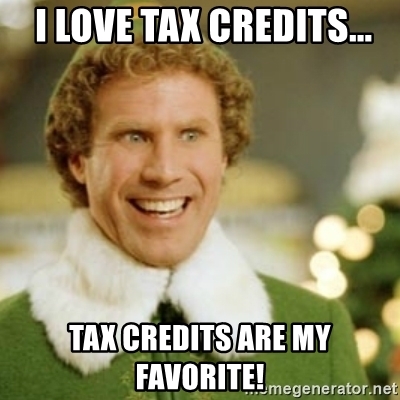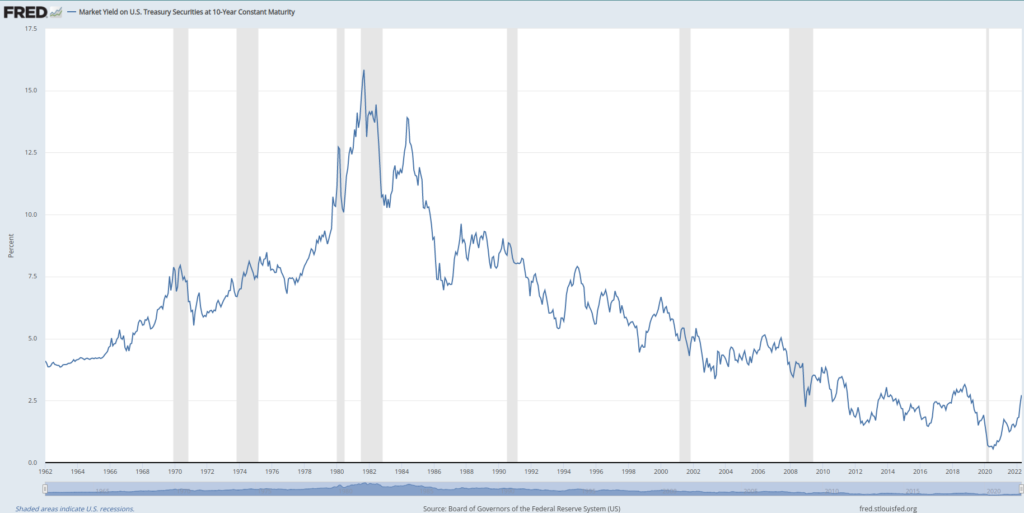“Nobody owes any public duty to pay more than the law demands: taxes are enforced exactions, not voluntary contributions.”
— Judge Learned Hand (Yes, surprisingly that was his real name!)
Whether you’re a small business owner, the founder of a fast-growing startup, or a high-income individual, knowledge of the tax code is even more powerful than compound interest.
Start with $1 and grow linearly at $0.10/year for 30 years. You end with $4. That’s labor.
Start with $1 and compound at 10%/year for 30 years. You end with $17.45! That’s compound interest (i.e. that’s business growth or investment).
Start with $1 and compound at 7%/year for 30 years. You end with $7.61. That’s a 30% tax rate on your business growth.
Cheeky statements aside, the point I’m illustrating is that the difference between untaxed exponential growth and taxed exponential growth is often BIGGER than the difference between taxed exponential growth and boring straight-line financial growth. That means investing the time necessary to understand key aspects of the tax code & strategize with them can be one of THE BIGGEST needle movers for your long-term success. Jeff Bezos knew this, which is why Amazon has been tax-optimizing since the beginning. It’s also why some really smart people struggle financially while some pretty basic people are able to become millionaires. It’s also why most of the 25+ million small businesses that record taxes as their single largest expense are doomed to underperform their more tax-efficient competitors.
I’m going to go over each of the most useful and powerful tax rules and loopholes with all of the key details you need to know about each in order to use them. However, I cannot cover them all in a single article. So, this will be the first of several articles over the next couple of weeks that will constitute my “tax series” in honor of tax season. By the end, you’ll be a nearly lethal tax assassin: slaying rather than paying most taxes in your path.

Lesson #1: You’ll always be a sucker if you don’t own something.
Almost every “loophole” in the tax code is actually a purposefully added incentive to own or buy some sort of property (the term property includes not just real estate but also vehicles, machinery, equipment, stock in a corporation, a percentage ownership of an LLC, etc).
Loopholes generally fall into one of two categories: (1) deductions (also called “write-offs”) or (2) credits. They are not the same. A deduction is subtracted from your taxable income before computing taxes. A credit is subtracted directly from your taxes after computing them initially. That means a dollar of tax credits is almost 3 times more valuable than a dollar of deductions for individuals in the highest tax bracket (37%), and the difference is even larger for corporations and lower-income individuals.
Example:
A corporation makes $100k of income. Since the corporate tax rate is 21%, the company would pay $21,000 of federal income tax.
If the corporation found a $10k tax deduction, their taxable income would drop from $100k to $90k, and the taxes owed would be 0.21 * $90,000 = $18,900 (a $2,100 savings).
If instead the corporation found a $10k tax credit, their taxable income would remain $100k, but the federal income tax would drop to $21,000 – $10,000 = $11,000 (a $10,000 savings).

In the remainder of this article I’ll describe one of the best tax loopholes related to home ownership.
NOTE TO FIRST-TIME STARTUP FOUNDERS (Everyone else, skip ahead to the next paragraph): If you’re anything like I was 8 years ago, you may be tempted to ignore this homeowner stuff to focus entirely on your business. Here’s exactly why you shouldn’t. The average first round of funding (sometimes called the seed or pre-seed round) for startups is typically around $15,000 – $200,000 for 5-25% of the business’s equity. Many first-time founders don’t have that much money, so they take the investment. But that amount of equity is actually quite significant. After all the rounds of investment Amazon has taken, Jeff Bezos only owns 10% of Amazon. Yet he has a net worth of $100B+. If founders were able to bootstrap long enough to avoid that need for early capital, they would end up significantly better off in the future. That’s where home ownership comes in. With an FHA loan, you can put down just 3.5% on a home, and it will become your investor. Not only will you be able to pay less to live than you would have otherwise had to pay in rent, but even a 10% rise in home prices would give you access to 3x your down payment amount through a low-interest-rate home equity loan. You can also rent out spare rooms (or the entire house if you move) to cover the mortgage payments and live for free while you work on your startup. And that’s just the start.
The Mortgage Point Loophole
Applies To: Humans only (not businesses)
How it Works: If you take out a mortgage of less than $750k to buy or build a primary residence, then you can take a deduction for the interest you pay on that loan each year.
For example, if you take out a $500k mortgage with a 4% interest rate to buy a home in January, then you’d pay about 0.04 * $500k = $20k in interest that year. You can then deduct that entire amount on your tax return. It gets even better though.
The tax code allows you to deduct mortgage discount points (which are essentially prepaid interest) in the same way as you deduct mortgage interest, EXCEPT that you can only deduct mortgage points on a mortgage loan taken out to buy or build a primary residence. You cannot deduct points for a second home or investment property.
A mortgage discount point is a percentage discount in your mortgage rate (most typically 0.25% so that e.g. buying one point would drop a 4% mortgage rate to a 3.75% mortgage rate). The cost of buying a mortgage point is almost always 1% of the total mortgage loan amount.
The math works out so that buying a mortgage point is the same as paying a small sum upfront rather than a larger sum over the duration of the mortgage loan. However, even though buying a point saves you money over the long-term, it also costs you more money during the first year (because the 1% you spent is more than the 0.25% you saved during the first year).
This creates the perfect tax setup because not only do you pay less interest, but you simultaneously pull forward a huge chunk of interest expense that you can write-off in the current year to offset other income. If you take out the maximum mortgage size allowed for this rule ($750k) and buy 4 points, you’d get a deduction of 4 * 0.01 * $750k = $30k. And that’s just from the points! You still get to also deduct any interest payments you make on the house that year.

Example
Florida man Gus buys a primary residence with a $750k mortgage by June of this year. His initial mortgage rate is 4%, but he buys three discount points that each provide a 0.25% discount. That means he pays 3 * 0.01 * $750k = $22.5k for the points, and his final interest rate is 3.25%. Since he bought the home before June, he still has at least half a year’s worth of interest payments to make. Those payments are about 0.5 * 0.0325 * $750k = $12.2k.
Gus’s total deduction attributable to interest on his primary residence is then the sum $22.5k + $12.2k = $34.7k. Not bad!
Bonus Benefits
Bonus #1: When you try to get clever with taxes, you can sometimes run into the very annoying “Alternative Minimum Tax” (AMT). The AMT is a whole second method of computing taxes which has a lower top bracket rate but also disallows many deductions. However, the type of primary residence acquisition mortgage interest deduction described in this loophole is allowed under both the regular and alternative minimum tax methods — Hurray!
Bonus #2: If you don’t fall into AMT territory, you can also deduct up to $10,000 in property taxes in addition to the interest deductions.
Bonus #3: If you are someone who typically takes the standard deduction, then buying a home without mortgage points may be wasteful from a tax perspective. To see why, you have to look at the big picture over several years rather than just one year. Suppose you take out a $250k mortgage at 4%. Your yearly interest payments will start off around 0.04 * $250k = $10k. If that was the only itemized deduction you could take, then it wouldn’t be worth even taking it since the standard, non-itemized deduction for an individual is over $12.5k. That means over the next 10 years, you’d have had tens of thousands of dollars of accumulated interest payments that couldn’t be deducted. However, if instead you purchased 4 mortgage points (costing 4 * 0.01 * $250k = $10k), then your total first year interest costs would be $10k (for points) + $7.5k (for interest payments at 3% since that is your final rate after buying 4 points) = $17.5k. Not only do you have an extra $5k deduction in that first year, but you also pay less interest and lose out on fewer deductions in later years. If that all seems confusing, just remember that if you typically take the standard deduction, then it benefits you to concentrate any non-standard deductions into a specific year.
Remember the big picture
Never forget that the high-level goal is to build wealth not minimize taxes. The deduction I’ve described is a DEDUCTION, not a CREDIT. It makes no sense to spend an extra $100k on a primary residence just to get a $100k deduction which saves you less than $50k in taxes. You can spend extra money buying points, but don’t buy a more expensive home than you otherwise would. The only exception to this would be if you plan to tax-hack by living in the house for the first year and then turning it into a rental property.
How many points should you buy?
After reading all of this, you may be tempted to buy as many mortgage points as your lender will sell you. Not so fast. Remember: The goal is to build wealth, not minimize taxes. The mortgage interest loophole is a DEDUCTION not a CREDIT. That means even if you’re in the highest tax bracket, only 37% of the amount you spend on points will be directly saved in taxes (even less if you’re in a lower tax bracket). Since 100% of the amount spent goes to reducing future interest expense, that means you’ve turned $1 into $1.37. BUT, that is dependent on one important assumption: that interest rates won’t drop significantly in the future. That’s because if interest rates drop, then you prepaid at a higher rate than you would have had to pay in the future which means rather than eliminating $1 worth of future interest rate payments for your $1 spent on points, you are maybe only eliminated $0.80 worth of future interest rate payments.
You can tolerate a small drop (e.g. using the numbers above, you paid $1 for $0.80 of interest benefits but also got $0.37 of tax benefits, leaving you with $1.17 overall). If interest rates drop significantly though, then maybe you prepaid $1 for only $0.50 of interest benefit, which means even including the tax benefit, you’re left with only $0.87 worth of value when you paid $1. That’s bad.
For the past 40 years, interest rates have been trending down. You can see that clearly in the chart below. The chart shows the interest rate on 10-year U.S. government treasury bonds (this rate is often just called the “10-year yield”). On average, 30-year mortgage interest rates tend to float about 2% over whatever the 10-year yield is.

All the way at the right side of the chart, you can see we are near all-time lows right now, so the risk of interest rate drops is not very large. However, as of 2022, the Federal Reserve has begun implementing a planned series of interest rate hikes. Those increases, together with the momentum of the increases (which will cause the gap between 10-year treasury rates and 30-year mortgage rates to likely remain higher than 2%), mean that mortgage rates will likely reach higher levels in 2023 or 2024 than the economy can withstand without a downturn.
Regardless of whether we officially enter a recession (definitely possible within the next 18 months) or just slow down a bit economically, it’s likely that interest rates will drop sometime thereafter in response. Then the cascade of interest rates will begin. The 10-year yield will come down from its highs, back to 2-3% at most. That in turn means 30-year fixed mortgage rates will probably fall down to 4-5% at most. It’s impossible to say what the exact timeframe of that rise and fall of interest rates will be, but I’d place odds that interest rates have fallen back to the levels I described within 5-10 years.
The reason I bring all of this up is that if 30-year mortgage rates rise to 7%, it doesn’t make financial sense to buy a fixed rate mortgage if you expect mortgage rates to fall back to 5% or lower (and it especially doesn’t make sense to prepay interest through points on that kind of mortgage). Instead, buying some type of variable rate mortgage loan would be preferable.
If I wanted to implement this strategy today, I would use a type of mortgage called a “10/6 ARM” and buy as many points as possible without pushing the “break-even” date of buying the points (vs just paying the interest) more than 10 years into the future and without the final interest rate dropping below 4%.
If you enjoyed this article, subscribe to the Axiom Alpha email newsletter which I publish 1-2 times a week typically. I write about tax strategies, the economics of different industries and business models, and more content aimed at giving entrepreneurs and investors superpowered nuggets of hyperpractical business & finance tactics. Join the community!
Appendix: Mortgage Point Limitations
Every great tax loophole has its limitations and compliance requirements. The IRS has 9 requirements that must be met in order for you to deduct mortgage points (some of these I’ve already mentioned):
- The mortgage loan must be secured by your primary residence (the home where you ordinarily live most of the time).
- You must use the loan money to buy or build your primary residence (so you can’t take out a mortgage to buy a second home NOR can you take a home equity loan out of your home to pay off credit card debt, for example).
- Paying for points must be an established business practice in the area where the loan was made (you can check this by calling a bank or other mortgage lender in your area).
- The points paid weren’t more than the points generally charged in the area.
- You use the cash method of accounting. This means you report income in the year you receive it and deduct expenses in the year you pay them. Most individuals use this.
- The points weren’t paid in place of amounts that are ordinarily stated separately on the settlement statement (e.g. appraisal fees, inspection fees, title fees, attorney fees, property taxes). The points MUST be “mortgage discount points” rather than any other type of “point” such as an “origination point” which doesn’t correspond to a deduction in interest rate.
- The total amount of money you provided before or at closing (including down payment, an escrow deposit, earnest money, and other funds you paid at or before closing for any purpose) must be at least as much as the cost of all the points you purchased.
- The points were figured as a percentage of the principal amount of the mortgage (i.e. 1 point costs 1% rather than 1 point costs $500 without regard for the total mortgage amount).
- The cost of the points is clearly shown on the settlement statement (e.g. Form HUD-1) as points charged for the mortgage. The points may be shown as paid from either your funds or the seller’s.